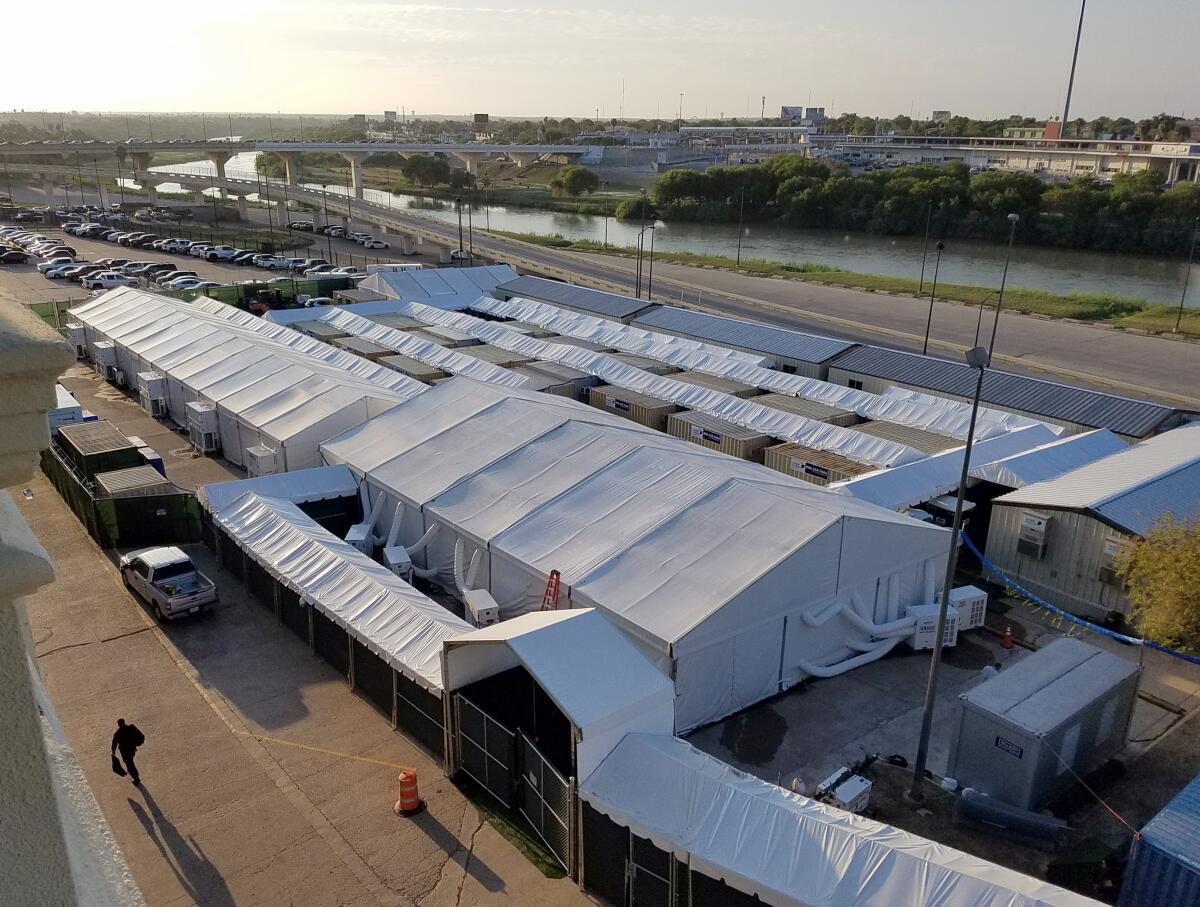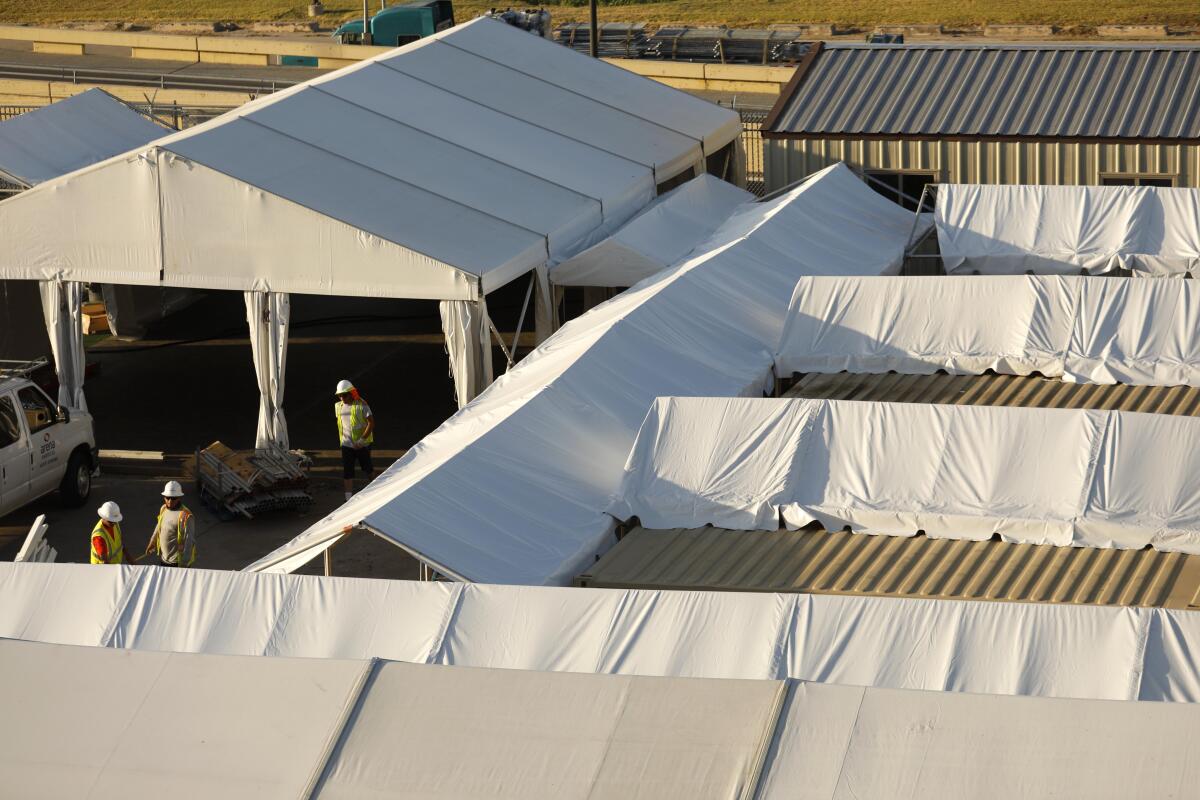Tent courthouses for migrants to open along Texas border, as questions abound

- Share via
LAREDO, Texas — Workers climbed atop a massive new U.S. immigration tent court on the banks of the Rio Grande at dawn Monday, adding the last few nails to the white roof, as generators hummed.
A line of people snaked across the nearby border bridge, streaming into the U.S. from Mexico to travel, work and go to school, passing by the fenced walkway to the new 36,000 square-foot tent court complex.
Months after construction began, much about Homeland Security’s $25-million tent courts in South Texas remains a mystery, even to lawyers who expect to represent their migrant clients as soon as this week. What day the hearings will begin, where lawyers should file paperwork and even whether attorneys can meet their clients beforehand — all remain unanswered questions in this border town.
“The question is who’s going to have jurisdiction over these courts?” said Leidy Perez-Davis, Washington, D.C.-based policy counsel for the American Immigration Lawyers Assn., whose members represent migrants scheduled to appear at the tents. “…There’s not a lot of transparency. The confusion is large and wide.”
Tent courts were erected here and in Brownsville, Texas, during the summer by U.S. Customs and Border Protection at a cost of $25 million, so far. At least 20 courtrooms are expected to process 200 to 250 people a day, according to Laredo city spokesman Rafael Benavides. The tent court in Brownsville is expected to handle around 720 migrants a day, according to the federal contract.
The city had offered to lease Homeland Security an air-conditioned, 21,000 square-foot office building for 18 months for only $1, but Homeland Security officials declined the offer, they said, “because of the importance of having an operational hearing facility within the following two months to ensure timely hearings for migrants.”
While federal immigration courts are public, the tent courts are unique because they were built on Homeland Security land. Homeland Security facilities generally are not open to the public beyond occasional press tours, meaning the public and the media could potentially be prevented from observing the hearings.
Access became a concern this summer after migrant advocates and the Office of the Inspector General reported squalid conditions at migrant holding areas in several South Texas Border Patrol stations. Homeland Security and U.S. Customs and Border Protection officials did not respond to requests from The Times to visit the tents or provide more information about how they will operate.
Immigration courts built inside other Homeland Security facilities, such as adult and family detention centers, are open to the public, though Homeland Security screens lawyers, reporters and other members of the public, in some cases banning them or requiring them to apply for access days in advance.
The tent courts are expected to exclusively host hearings for migrants who have been returned to Mexico to await the outcome of their asylum cases under the Trump administration’s “Remain in Mexico” program, which started in California in January and expanded to Laredo in July. The program has resulted in the return of more than 37,000 migrants to Mexico, many now stuck in overcrowded shelters or makeshift border encampments.
In recent days, the Border Patrol returned an average of 125 migrants daily to Laredo’s sister city, Nuevo Laredo. Borderwide, roughly 1,200 migrants are returned to Mexico daily, officials told Laredo Mayor Pete Saenz.
Immigration judges have been hearing “Remain in Mexico” cases in San Diego and El Paso for months, but in bricks-and-mortar courtrooms, open to the public as space allows.
Rep. Henry Cuellar, a Democrat who represents Laredo, and Saenz said they were told by Homeland Security officials that immigration judges in San Antonio would conduct the tent court hearings via video conference starting Sept. 16, which is Independence Day, a national holiday in Mexico. Migrants’ attorneys said at least one person was scheduled to appear before that, on Thursday.
Adding to the confusion, attorneys said they have been unable to determine which federal agency controls access to the tents and whether they would be allowed to meet with asylum seekers there privately before a client’s hearing.
“It’s definitely going to affect the ability to represent clients and to help these asylum seekers. Attorneys have no idea where to file the paperwork necessary for these hearings; they don’t know what court will have jurisdiction; they don’t know if they’re supposed to go to the court where their client is or where the judge will be. We don’t know if there will be interpreters,” said Perez-Davis. “What we’re going to see is massive confusion.”
Denise Gilman, co-director of the immigration clinic at the University of Texas School of Law, said she has been visiting migrants in Nuevo Laredo, including one scheduled to appear at the tent courthouse this week. She said the clinic did not plan to represent them because the logistics made it impossible to meet migrants before their hearings.
“I just don’t want to partake of a system that is not set up to adjudicate but, rather, to exclude… It is really just a mock-up of a court,” she said.

A spokeswoman for the federal immigration courts referred questions about the tent courts to Homeland Security. Spokesmen for Homeland Security and Border Patrol said they were still trying to clarify who would be given access to the tent courts.
A Homeland Security official said that the agency “understands the need to protect the privacy and due process rights of individuals who will appear at these locations” and promised that the agency would quickly “determine how best to balance these rights with the special security issues that we must confront at an active port of entry.”
Cuellar, a former lawyer who toured the tents in July, said they sit alongside a dozen air-conditioned metal containers where he was told lawyers would be allowed to meet with their clients. He plans to tour the tent court on Tuesday.
“I want to make sure we look at what’s the process there, where they meet with an attorney, where the video conference is going to be,” he said.
Cuellar said Homeland Security’s decision to reject the city’s offer of near-free use of a municipal building left him feeling cynical.
“It’s a waste of taxpayers’ money,” Cuellar said of the tents. “They’re trying to get visuals: tents, barbed wire, National Guard, wall… They’re manufacturing a crisis here.”
More to Read
Sign up for Essential California
The most important California stories and recommendations in your inbox every morning.
You may occasionally receive promotional content from the Los Angeles Times.











